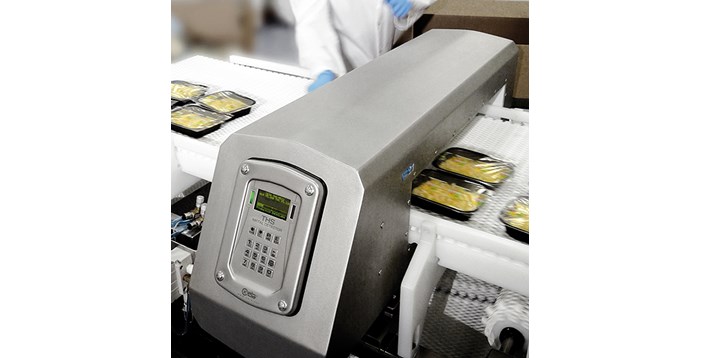How to choose the best metal detector for your product and production environment Leave a comment
Protecting your brand in the market is one of the most important things a food manufacturer must do. But every investment to build a reputation for product quality can be lost just because of a case of product recall. Develop and maintain effectively. Developing and maintaining a product performance testing program is no longer a good choice for manufacturers. Metal detection is an effective and less expensive method of protecting your customers and brands. While prices, distributors and other commercial conditions are critical to branding, technology is a key factor in evaluating metal detectors and building trust in the brand’s reputation.

Food in the tray goes through the metal detector
Product effect
Product effect is an important factor in choosing a metal detector. If your product is conductive (usually due to water, salt, or iron content), they will affect the magnetic field of the metal detectors, leading to false detection and misplacement. . Dry or neutral products generall y do not cause this effect.
Food in aluminum foil packaging is being inspected
If the product effect is a factor, the frequency selection must be correct to signal the product away from the signals of the contaminants. Metal detectors that use a single frequency are not customizable when the signal changes because it is not suitable for checking a wide range of products or products that may change temperatures. A multi-spectral metal detector with 3 or more frequencies would be more suitable for these applications.
The most sophisticated metal detectors on the market today use multi-spectral technology. As an alternative to a single-frequency detector, the multi-frequency metal detector can recognize product signals more efficiently than frequency-1 type, in addition, the number of times the error is reported will be incorrect. significantly reduced.
Features self-recover and remember data
Metal detectors will become an important part of the production quality management program. This new metal detector is not only sensitive to product signals but also easy to set up, use, and eliminate the wrong product at the lowest level. Most metal detectors on the market today have a self-test function to determine the stability of the machine.
The self-remembering data feature allows the operator to identify the product features included in the machine, so product inspections can be performed without reinstall ing. The effective self-remembering feature provides the best sensitivity and the elimination of false products is minimal with minimal manual adjustment.
Sensitivity and connection port
The demand for the sensitivity of metal detectors often varies with manufacturing stages. For example, the main function of a metal detector is to protect an important part of production equipment such as a cutter or slicer. The goal here is to remove metal fragments large enough to damage the device.
At another stage of the production line, another sensitivity is required to test a large number of products. And because checking the packaged product at the end of the production line is the highest requirement, a higher sensitivity setting is needed to protect the product before it is marketed.
The plant’s quality control department must give specific sensitivity to various metal components including non-ferrous, iron and stainless steel (type 316) for each stage of production. These requirements must be informed to the manufacturers of metal detectors so that they can select the appropriate equipment for each application. Be sure to set realistic and feasible goals.
Consider the environment
Start by evaluating your test area. Is the environment humid or dry? How does the temperature change? Choosing a metal detector that fits your production environment is important. Water penetration into electrical components is one of the most common causes of metal detector performance. If there is a discharge system in the factory, is the pressure high or low? IP65 environmental impact rating means that the metal detector can only withstand low pressures with water temperature. And the IP69K rating means that it can withstand high pressures and temperatures. But be careful: ratings are often self-reported. The reputation of the manufacturer in an industry that is resistant to heat, dust and water is usually a good indicator.
Is this exhaust system corrosive? If so, pay special attention to the special alloys of stainless steel used in metal detectors. 316L stainless steel is more resistant to abrasive agents than ordinary types.
For dry environments, are metal detectors covered with varnish? Coating the glossy surface on the surface of the product flow may stain the product with paint chips.
What about the impact resistance? Impact-resistant plastic screen and protective layer. The display screen and keyboard certainly restricts downtime and the cost of replacing accessories
Consider the means of connection
Is the metal detector a standalone device or should it be integrated into the plant’s network, providing periodic reporting data for statistical software? Does a metal detector have software that already has these functions? Is there an Ethernet port available? Some manufacturers offer software that allows remote programming and diagnostics via a laptop, including oscilloscope via Bluetooth, without opening the power box.
Developing sensitivity standards for each product will help you choose the most suitable metal detector.
Event tracking
Regulations in food production are becoming more and more required, production equipment must meet these regulations. Request






